新版新目标八下教案Unit-6-An-old-man-tried-to-move-the-mountains-(1)
- 格式:doc
- 大小:109.00 KB
- 文档页数:5
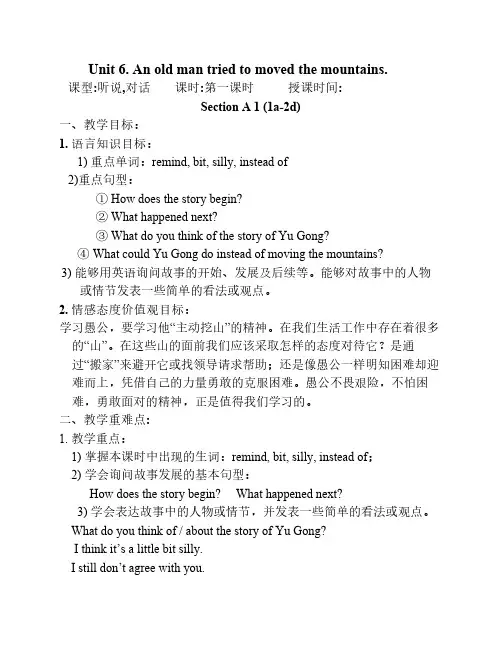
Unit 6. An old man tried to moved the mountains.课型:听说,对话课时:第一课时授课时间:Section A 1 (1a-2d)一、教学目标:1. 语言知识目标:1) 重点单词:remind, bit, silly, instead of2)重点句型:① How does the story begin?② What happened next?③ What do you think of the story of Yu Gong?④ What could Yu Gong do instead of moving the mountains?3) 能够用英语询问故事的开始、发展及后续等。
能够对故事中的人物或情节发表一些简单的看法或观点。
2. 情感态度价值观目标:学习愚公,要学习他“主动挖山”的精神。
在我们生活工作中存在着很多的“山”。
在这些山的面前我们应该采取怎样的态度对待它?是通过“搬家”来避开它或找领导请求帮助;还是像愚公一样明知困难却迎难而上,凭借自己的力量勇敢的克服困难。
愚公不畏艰险,不怕困难,勇敢面对的精神,正是值得我们学习的。
二、教学重难点:1. 教学重点:1) 掌握本课时中出现的生词:remind, bit, silly, instead of;2) 学会询问故事发展的基本句型:How does the story begin? What happened next?3) 学会表达故事中的人物或情节,并发表一些简单的看法或观点。
What do you think of / about the story of Yu Gong?I think it’s a little bit silly.I still don’t agree with you.2. 教学难点:学会表达故事中的人物或情节,并发表一些简单的看法或观点。
三、教法学法: 听说,小组合作,观察对比.四、教学用具: 课件, 听力材料音频.五、教学过程:Step 1. Lead in1. 播放动画片《寓公移山》的视频,导入本单元主题。
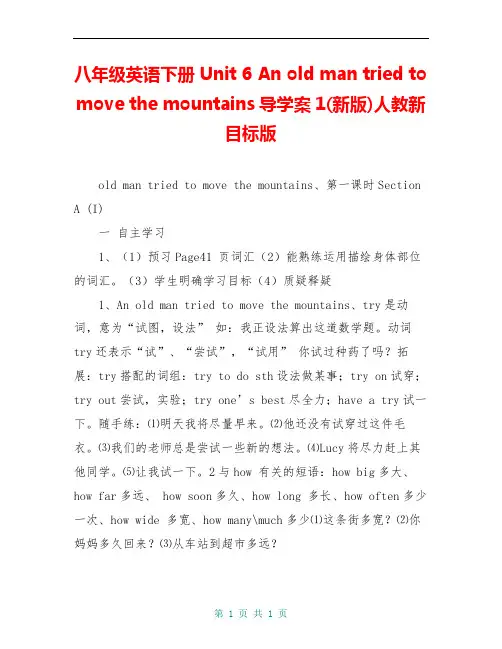
八年级英语下册 Unit 6 An old man tried to move the mountains导学案1(新版)人教新目标版old man tried to move the mountains、第一课时Section A (I)一自主学习1、(1)预习Page41 页词汇(2)能熟练运用描绘身体部位的词汇。
(3)学生明确学习目标(4)质疑释疑1、An old man tried to move the mountains、try是动词,意为“试图,设法” 如:我正设法算出这道数学题。
动词try还表示“试”、“尝试”,“试用” 你试过种药了吗?拓展:try搭配的词组:try to do sth设法做某事;try on试穿;try out尝试,实验;try one’s best尽全力;have a try试一下。
随手练:⑴明天我将尽量早来。
⑵他还没有试穿过这件毛衣。
⑶我们的老师总是尝试一些新的想法。
⑷Lucy将尽力赶上其他同学。
⑸让我试一下。
2与how 有关的短语:how big多大、how far多远、 how soon多久、how long 多长、how often多少一次、how wide 多宽、how many\much多少⑴这条街多宽?⑵你妈妈多久回来?⑶从车站到超市多远?3、 In1972, it was discovered that they are endangered、1972年,人们发现它们已经濒于灭绝。
was discovered是一般过去时的被动语态,discover“发现”,近义词为find和invent。
【友情链接】discover, invent与find◎discover指发现过去所不知道的东西,新奇或意外的东西。
Coal was first discovered and used in China、中国首先发现并使用了煤。
Columbus discovered America on the12th of October,1492、1492年10月12日,哥伦布发现了美洲。
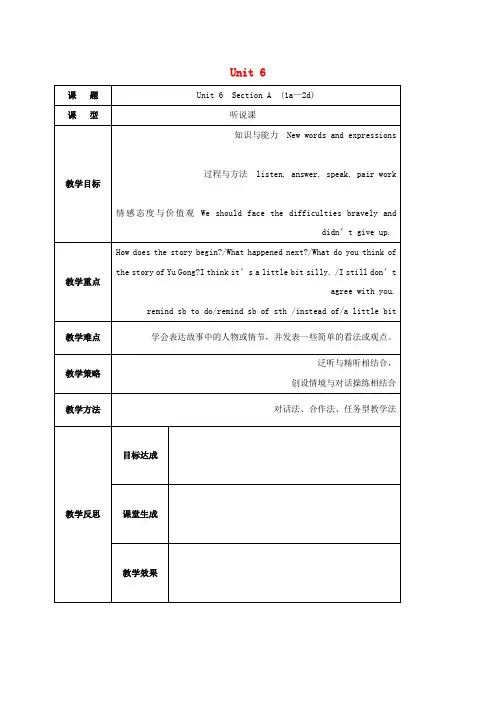

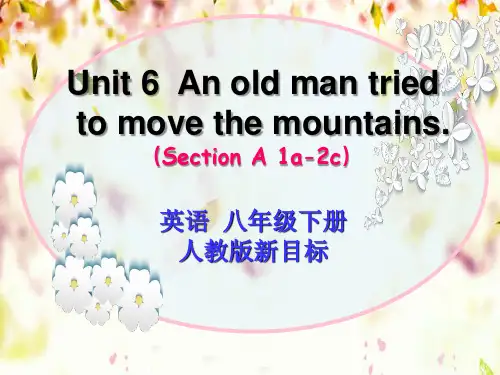
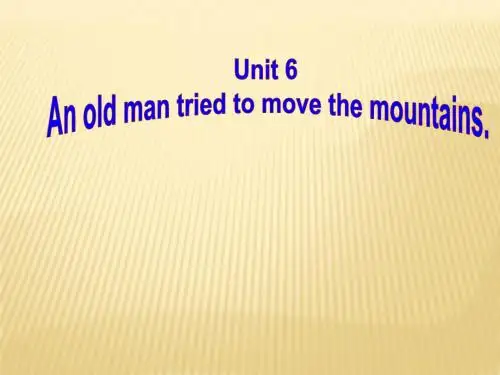
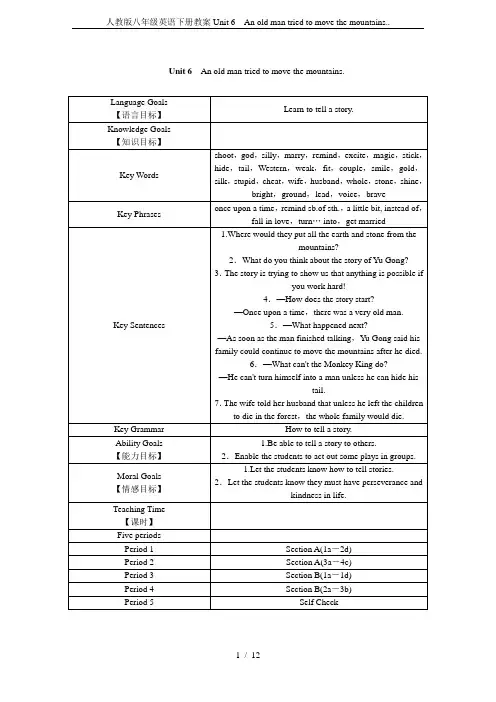
Unit 6An old man tried to move the mountains.本单元教材以“谈论故事情节”为中心话题,围绕着学生非常熟悉的故事进行,学习和运用几个常见的句型:Where would they put all the earth and stone from the mountains?/What do you think about the story of Yu Gong?/The story is trying to show us that anything is possible if you work hard!/—How does the story start?—Once upon a time,there was a very old man./—What happened next?—As soon as the man finished talking,Y u Gong said his family could continue to move the mountains after he died.等。
在学习过程中,学生在交流中,能促进师生之间的感情。
Section A 主要学习once upon a time,remind sb.of sth.,a little bit, instead of,turn… into,get married等几个常见的短语及怎样讲故事。
通过短文介绍了《西游记》在英国放映的事情,增加了学生的阅读量。
Section B 安排了听、说、读、写的任务,通过《皇帝的新装》来训练学生的听力,通过《韩赛尔与格雷特》训练学生的阅读能力。
教师在教学中应合理利用课本上的知识进行教学。
第一课时Section A(1a-2d)Teaching Key Points【教学重点】The vocabulary:shoot,stone,weak,god,silly,remind sb.of sth.,a little bit, instead ofTarget language:1.Where would they put all the earth and stone from the mountains?2.What do you think about the story of Yu Gong?3.The story is trying to show us that anything is possible if you work hard!Teaching Difficult Points【教学难点】Use the target language above to tell a story.Teaching Aids【教学工具】an English book,a tape recorder and CAITeaching Steps【教学过程】★Step 1Preview and perception【预习感知】Ask the students to read the vocabulary and target language.Ⅰ.根据句意及汉语或首字母提示写单词。
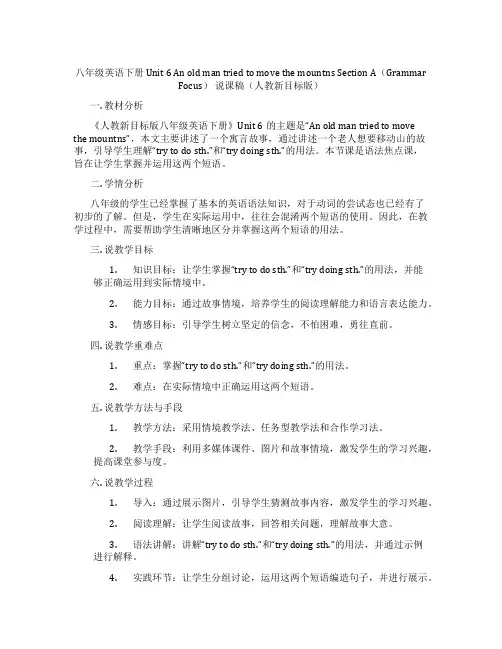
八年级英语下册 Unit 6 An old man tried to move the mountns Section A(GrammarFocus)说课稿(人教新目标版)一. 教材分析《人教新目标版八年级英语下册》Unit 6的主题是“An old man tried to movethe mountns”,本文主要讲述了一个寓言故事,通过讲述一个老人想要移动山的故事,引导学生理解“try to do sth.”和“try doing sth.”的用法。
本节课是语法焦点课,旨在让学生掌握并运用这两个短语。
二. 学情分析八年级的学生已经掌握了基本的英语语法知识,对于动词的尝试态也已经有了初步的了解。
但是,学生在实际运用中,往往会混淆两个短语的使用。
因此,在教学过程中,需要帮助学生清晰地区分并掌握这两个短语的用法。
三. 说教学目标1.知识目标:让学生掌握“try to do sth.”和“try doing sth.”的用法,并能够正确运用到实际情境中。
2.能力目标:通过故事情境,培养学生的阅读理解能力和语言表达能力。
3.情感目标:引导学生树立坚定的信念,不怕困难,勇往直前。
四. 说教学重难点1.重点:掌握“try to do sth.”和“try doing sth.”的用法。
2.难点:在实际情境中正确运用这两个短语。
五. 说教学方法与手段1.教学方法:采用情境教学法、任务型教学法和合作学习法。
2.教学手段:利用多媒体课件、图片和故事情境,激发学生的学习兴趣,提高课堂参与度。
六. 说教学过程1.导入:通过展示图片,引导学生猜测故事内容,激发学生的学习兴趣。
2.阅读理解:让学生阅读故事,回答相关问题,理解故事大意。
3.语法讲解:讲解“try to do sth.”和“try doing sth.”的用法,并通过示例进行解释。
4.实践环节:让学生分组讨论,运用这两个短语编造句子,并进行展示。
5.课堂巩固:设计相关的练习题,让学生进行巩固练习。
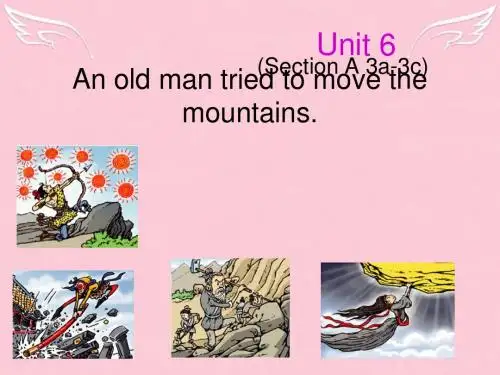
《Unit 6 An old man tried to move the mountains.》
一、教学目标: 1. 语言知识目标: 能熟练运用描绘身体部位的词汇。 2. 情感态度价值观目标: 做一个有恒心有毅力的人。 二、教学重点: 状语从句 三、教学难点: 条件状语从句 四、教学方法: Task-based and communicative teaching methods. 五、授课时间:5.3——5.6 六、课时安排:4课时 七、教学过程:
Period 1 一 自主学习 1.(1)预习Page41 页词汇(2)能熟练运用描绘身体部位的词汇。 (3)学生明确学习目标 (4)质疑释疑1.An old man tried to move the mountains. try是动词,意为“试图,设法” 如:我正设法算出这道数学题。 动词try还表示“试”、“尝试”,“试用” 你试过种药了吗? 拓展:try搭配的词组:try to do sth设法做某事;try on试穿;try out尝试,实验;try one’s best尽全力;have a try试一下。 随手练:⑴明天我将尽量早来。 ⑵他还没有试穿过这件毛衣。 ⑶我们的老师总是尝试一些新的想法。 ⑷Lucy将尽力赶上其他同学。 ⑸让我试一下。 2与how 有关的短语:how big多大、how far多远、 how soon多久、how long 多长、how often多少一次、how wide 多宽、how many\much多少 ⑴这条街多宽? ⑵你妈妈多久回来? ⑶从车站到超市多远? 3. In 1972, it was discovered that they are endangered. 1972年,人们发现它们已经濒于灭绝。 was discovered是一般过去时的被动语态,discover“发现”,近义词为find和invent。 【友情链接】discover, invent与find ◎discover指发现过去所不知道的东西,新奇或意外的东西。 Coal was first discovered and used in China. 中国首先发现并使用了煤。 Columbus discovered America on the 12th of October, 1492. 1492年10月12日,哥伦布发现了美洲。 ◎invent意为“发明”,即创造出以前从未存在过的东西。 Edison invented the electric lamp.爱迪生发明了电灯。 Radio had just been invented then.那时无线电刚刚发明出来。 ◎find意为“找到”,侧重于找到过去丢失的人或物,但有时也表示凭经验或偶然发现了一种东西。 Today, corn is found all over the world.今天,全世界都有了玉米。 She found him a very good pupil.她发现他是个非常好的学生。 ◎有时find和discover可以互相替代,意思相同。 His notebook was found/discovered in the desk. 他的笔记本是在课桌里找到的。 4.Some of the swamps have become polluted. 一些沼泽地受到了污染。 have become polluted 中的become是连系动词,polluted是过去分词。这种“系动词+过去分词”结构,意思上也接近被动语态。 The slodier got wounded(接近were wounded)in the battle. 这几名战士在这场战斗中受了伤。 A few minutes later, the ground became/was covered with snow. 几分钟后地上尽是雪。 5.I’m like this animal because I am strong and intelligent.I like water,and I like to eat vegetables. 我像这种动物因为我有强壮又聪明。我喜欢水,我喜欢吃蔬菜。 板书设计: be like 像 look like 看起来像 like sth.喜欢某物 like to do sth.喜欢做某事 like sb. To do sth.喜欢某人做某事
第二课时Section A (II) (一).自主学习:掌握单词remind god weak instead of hide magic (二)质疑释疑 1.against介词必须和be或其它动词一起用,表示“与„„对抗” Our school played against K High School at baseball. We are for peace and against war. 2、visit及物动词,名词是visitor 也可用作名词,表示参观.访问.常构成词组 make a visit to„„(参观,访问)be on a visit to„„(正在参观/访问中)go on a visit to„„(去访问,去参观)This is my first visit to Beijing. Mr. Brown is on a visit to China. 3. Keep的用法,keep doing sth. 意思是继续不断的做某事,一直做某事. The baby kept crying until his mother came back. keep其他用法 (1).keep+adj. 意思是保持某种状态You must keep quiet in the library. (2). keep+sb/sth +表地点的介词短语。意思是让某人一直在某地, you’d better keep the chicken in the fridge. (3). Keep sb,/sth.from doing sth.意思是防止某人/某物做某事. The policemen kept the children form crossing the road when it was dangerous. (4). Keep on doing sth.意思是反复做某事.Don’t keep on shouting at me. 3.They provide homes for many endangered animals.他们为许多濒临灭绝动物提供家园„ provide是及物动词,意为“提供”,“供给”。表示“提供„„人„„物件”是provide...with...;“提供„„给„„人”是provide...for...。 The school provides us with all the materials we need. 学校提供我们所需要的一切资料。 We are provided with everything we need for work. 我们被提供了工作所需要的一切。 The school provides all the books we need for us. 学校为我们提供我们需要的书籍。 【友情提示】 ◎ provide for是“供养”的意思。 He has a large family to provide for. 他要养活一个大家庭。 4. and help to educate the public about caring for them.(P120)并且帮助教育公众关爱它们。 care for表示“喜欢”,“关心”之意,后接名词或v-ing形式作宾语,take care of也有这个意思。 He cared nothing for skating. 他对滑冰没有兴趣。 In our class, we care for each other. 在我们班上,我们相互关心。 Maria takes good care of everybody. 玛丽亚很关心大家。 【友情链接】care for还可以表示“照顾”,“照料”,相当于take care of或look after。 At night he fed and cared for the cattle. 夜里他照料牲口,给牲口喂食。 You must care for yourselves. =You must look after yourselves.你们要照顾好自己。 The children are well cared for in the nurseries. =The children are taken good care of in the nurseries. 孩子们在托儿所受到很好的照顾。 (三).当堂检测 Ⅰ.从方框中选择适当的单词,并用其正确的形式填入句子中。有些选项是多余的。 1.Many people are worried about the __________ animals. 2.Have you ever________ a zoo before? 3.I don’t think zoos are _________ places for animals to live. 4.Tigers and some dangerous animals ____________ in cages in the zoo. 5.It’s necessary __________the zoo. 6.A zoo is a ___________ textbook for us. 7.This TV program __________ people to protect the environment. 8.Some large animals can_________ move in the cage. Ⅱ.根据句意和首字母提示,完成句中单词。 1.It’s dangerous for animals to drink if the water becomes p . 2.Some animals are g and friendly to people. 3.The animal weighs about 200 p . 4.This is a habitat that has never been d by people.